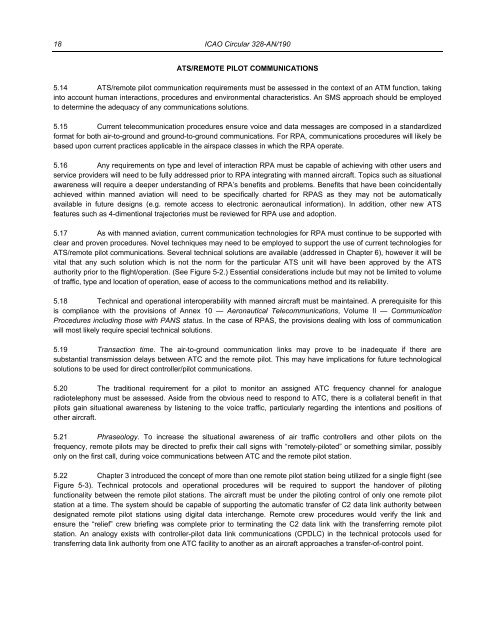1AswVkP
1AswVkP
1AswVkP
Create successful ePaper yourself
Turn your PDF publications into a flip-book with our unique Google optimized e-Paper software.
18 ICAO Circular 328-AN/190<br />
ATS/REMOTE PILOT COMMUNICATIONS<br />
5.14 ATS/remote pilot communication requirements must be assessed in the context of an ATM function, taking<br />
into account human interactions, procedures and environmental characteristics. An SMS approach should be employed<br />
to determine the adequacy of any communications solutions.<br />
5.15 Current telecommunication procedures ensure voice and data messages are composed in a standardized<br />
format for both air-to-ground and ground-to-ground communications. For RPA, communications procedures will likely be<br />
based upon current practices applicable in the airspace classes in which the RPA operate.<br />
5.16 Any requirements on type and level of interaction RPA must be capable of achieving with other users and<br />
service providers will need to be fully addressed prior to RPA integrating with manned aircraft. Topics such as situational<br />
awareness will require a deeper understanding of RPA’s benefits and problems. Benefits that have been coincidentally<br />
achieved within manned aviation will need to be specifically charted for RPAS as they may not be automatically<br />
available in future designs (e.g. remote access to electronic aeronautical information). In addition, other new ATS<br />
features such as 4-dimentional trajectories must be reviewed for RPA use and adoption.<br />
5.17 As with manned aviation, current communication technologies for RPA must continue to be supported with<br />
clear and proven procedures. Novel techniques may need to be employed to support the use of current technologies for<br />
ATS/remote pilot communications. Several technical solutions are available (addressed in Chapter 6), however it will be<br />
vital that any such solution which is not the norm for the particular ATS unit will have been approved by the ATS<br />
authority prior to the flight/operation. (See Figure 5-2.) Essential considerations include but may not be limited to volume<br />
of traffic, type and location of operation, ease of access to the communications method and its reliability.<br />
5.18 Technical and operational interoperability with manned aircraft must be maintained. A prerequisite for this<br />
is compliance with the provisions of Annex 10 — Aeronautical Telecommunications, Volume II — Communication<br />
Procedures including those with PANS status. In the case of RPAS, the provisions dealing with loss of communication<br />
will most likely require special technical solutions.<br />
5.19 Transaction time. The air-to-ground communication links may prove to be inadequate if there are<br />
substantial transmission delays between ATC and the remote pilot. This may have implications for future technological<br />
solutions to be used for direct controller/pilot communications.<br />
5.20 The traditional requirement for a pilot to monitor an assigned ATC frequency channel for analogue<br />
radiotelephony must be assessed. Aside from the obvious need to respond to ATC, there is a collateral benefit in that<br />
pilots gain situational awareness by listening to the voice traffic, particularly regarding the intentions and positions of<br />
other aircraft.<br />
5.21 Phraseology. To increase the situational awareness of air traffic controllers and other pilots on the<br />
frequency, remote pilots may be directed to prefix their call signs with “remotely-piloted” or something similar, possibly<br />
only on the first call, during voice communications between ATC and the remote pilot station.<br />
5.22 Chapter 3 introduced the concept of more than one remote pilot station being utilized for a single flight (see<br />
Figure 5-3). Technical protocols and operational procedures will be required to support the handover of piloting<br />
functionality between the remote pilot stations. The aircraft must be under the piloting control of only one remote pilot<br />
station at a time. The system should be capable of supporting the automatic transfer of C2 data link authority between<br />
designated remote pilot stations using digital data interchange. Remote crew procedures would verify the link and<br />
ensure the “relief” crew briefing was complete prior to terminating the C2 data link with the transferring remote pilot<br />
station. An analogy exists with controller-pilot data link communications (CPDLC) in the technical protocols used for<br />
transferring data link authority from one ATC facility to another as an aircraft approaches a transfer-of-control point.


